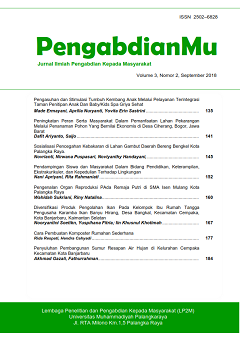Cara Pembuatan Komposter Rumahan Sederhana How to Make Simple Home Based Composter
Main Article Content
Abstract
The increase in population in Palangka Raya each year results in an increase in the waste produced. The increase in the amount of garbage was apparently not followed by an increase in temporary waste disposal facilities (TPS). Based on the results of previous research it was found that for the Pahandut Subdistrict of Palangka Raya City the waste generation produced was not comparable to the capacity of the TPS capacity. It was stated that the capacity of the TPS was only 45% of the waste generation that occurred per day. As a result, a lot of garbage is scattered outside the TPS and some are dumped into rivers and drainage channels. Based on the foregoing, a proposal arises to reduce the problem of waste generation. One such proposal is to reduce the initial source of waste from individual households. However, to reduce household waste, of course, it needs an effort to provide knowledge to the public about the waste sorting efforts that occur. Community participation in addressing the problem of municipal waste is very dominant, and this level of participation should be the main barometer in future waste management. To increase the role of the community in dealing with waste issues we propose an idea as a solution. The idea is to utilize household waste into compost. For this reason, it is necessary to provide a socialization on how to make compost from household waste. Therefore we made socialization with the topic of How to Make Simple Home Composter.
Downloads
Article Details
Authors who publish with this journal agree to the following terms:
- Any article on the copyright is retained by the author(s).
- Author grant the journal, right of first publication with the work simultaneously licensed under a Creative Commons Attribution License that allows others to share work with acknowledgment of the work authors and initial publications in this journal.
- Authors are able to enter into a separate, additional contractual arrangements for non-exclusive distribution of published articles of work (eg, post-institutional repository) or publish it in a book, with acknowledgment of its initial publication in this journal.
- Authors are permitted and encouraged to post their work online (e.g., in institutional repositories or on their websites) prior to and during the submission process, as can lead to productive exchanges, as well as earlier and greater citation of published work.
- The article and any associated published material is distributed under the Creative Commons Attribution-ShareAlike 4.0 International License
References
Direktorat Jenderal Cipta Karya. 1986. Materi Training Untuk Tingkat Staf Teknis Proyek Plp Sector Persampahan. Jakarta: Direktorat Jenderal Cipta Karya.
Dedy, Rimawan. 2014. Study Pengelolaan Persampahan Kec. Pahandut, Kota Palangkaraya. Universitas Muhammadiya Palangkaraya. Palangka Raya.
Hadiwiyoto, S. 1983. Penanganan dan Pemanfaatan Sampah. Jakarta: Yayasan Idayu.
Kartikawan, Yudhi. 2007. Pengelolaan Persampahan. Jurnal Lingkungan Hidup. Yogyakarta
Kodoatie, Robert, 2005. Manajemen dan Rekayasa Infrastruktur. Yogyakarta: Pustaka Pelajar.
Rao. 1996. Measuring Consumers Perceptions Throught Factor Analysis. The Asian Managers
Santoso, Nurman. 1990. Pendidikan di Indonesia (Dari Masa ke Masa). Jakarta: Haji Masagung.
